|
|
Cleopatra's Needle (Paris)
| Present Site: | Place de la Concorde, Paris, France N 48°51'55.7"(48.865483) E 2°19'16.0"(2.321122) |
| Pharaoh: | Ramses II (New Kingdom 19th Dynasty, Reigned 13 Century BC) |
| Measurement: | 22.55 meters high |
| Weight: | Estimated 227 tons |
| Stone: | Red granite |
About The Site:
Place de la Concorde is one of the major squares of Paris, with an area of about 8.6 hectares, is the largest open public space in Paris. This square was made in the mid 18 century, and initially was called as the Louis XV Square, was renamed to the Revolution Square at the time of the French Revolution, then became the Place de la Concorde in 1830 as an official name. In the west direction from the Place de la Concorde, Champs-Élysées is extending to the Arc de Triomphe, the east side of the square is the Tuileries Garden, and Palais Bourbon, housing the French National Assembly, sits in south across the Seine River.
Although the view of Champs-Élysées from the Place de la Concorde is stirring, but two magnificent stone buildings on north side are also impressive. Left (east) side building is the French Naval Ministry, and right (west) side is Hôtel de Crillon.
Place de la Concorde is the center of Paris, it is one of the top tourist destinations in the world. Obelisk standing in the center of this square is also the symbolic presence of the Place de la Concorde. This would be an obelisk at which the most a lot of people are looking all over the world, hence this would probably be the most cheerful Obelisk in the world.
 The obelisk which is standing at the most honorable place in the world The obelisk which is standing at the most honorable place in the world
|
How To Get There:
The closest station of the public transportation is Concorde [Station] on Métro Lines 1, 8, and 12. The station is just north side of the square, Place de la Concorde can be found easily when you go out to the ground from the station. You can also approach by walk Champs-Élysées from the Arc de Triomphe. It's about 2.1 km. Also from Louvre Museum, you can approach by walk either along the Seine River or passing through the Tuileries Garden. In this case, it's about 1.2 km. Since both the Arc de Triomphe and Louvre Museum are the leading sightseeing spots, you may go to the Place de la Concorde when you visit those spots.
About The Obelisk:
Cleopatra's Needle: This obelisk is called "Cleopatra's Needle". The obelisks in Central Park of New York and in Victoria Embankment of London are also called "Cleopatra's Needle". New York's and London's ones were brought from Alexandria, initially erected by Thutmose III. But this obelisk was brought from Luxor, erected by Ramses II. As such, the origin of other two Cleopatra's Needle is different from this obelisk, but they all are called by the same nickname for some reason.
Carrying Out from Luxor: French Government was thinking for obtaining the obelisk from Egypt, and on June 8th, 1831, a French naval engineer named Jean Baptiste Apollinaire Lebas secured permission from the then Egyptian viceroy Mohammed Ali to make off with one of obelisks before Luxor Temple. Initially it was planned to carry out both two obelisks which stand in front of the Luxor temple, but the right side of the obelisk which was preserved with relatively good condition among the left and right was firstly carried away. Behind of this, there was an advice of Champollion who deciphered the hieroglyphs. Then, on October 25th, 1836, this was erected at the center of Place de la Concorde in Paris, in the presence of French King Louis Philippe, and all this great project was finally completed.
For Muhammad Ali who gave the authorization for relocation of this obelisk, a large clock was awarded in return from King Louis Philippe. The clock is still in the Cairo Citadel, also remains now is fitted to the clock tower facing the courtyard of the Mosque of Muhammad Ali. On the other hand, for Lebas who involved in all of the reconstruction, from the authorization of the procedure to transportation, medallion and prize was bestowed.
With regard to another left side of pair of the Luxor Obelisk, it was left as it is without being taken out and remained there because the relationship of France and Egypt have deteriorated.
Gold Pyramidion: When you now look at this obelisk, you will find the strangely glittering pyramidion at the top. This golden cap was newly added in May 1998. This pyramidion is made with bronze and 23.5-carat gold leaf, 3.6-meter (12 feet) high. This can be well seen depending on an angle even from a distance. This was placed on top of this obelisk at the beginning. But the historians believe its original pyramidion was stolen in the 6th century BC by Assyrian or Persian invaders. When this obelisk was re-erected in 1836, experts urged the French authorities to restore the masterpiece to its original splendor by putting a pyramidion back on the pinnacle. But it was not until French President Jacques Chirac agreed in 1997 to back the 1.5 million franc (US$252,000) project as part of celebrations to mark Franco-Egyptian relations. I don't feel this metallic shining pyramidion is suitable with an aged stone-made obelisk. Would this sense of incongruity be lost if this also passes through years?
Inscription on Pedestal: At the base part (pedestal) of this obelisk, there are gold painted inscriptions. First, on the east face of the pedestal, the provenance is described in Latin. On the west face, the provenance is described in French, but the contents are slightly different from Latin. On the north and south faces, the status of transportation of the obelisk is illustrated. On the north face, the status of carrying out from the Luxor Temple, and the south face, the status of erection in Place de la Concorde in Paris are illustrated. See pictures below.
Comparing with the Obelisk Remains in Luxor: Next, I will try to compare with the left side of obelisk that remains in the Luxor Temple. Since the Ancient Egyptians considers the symmetry was very important, there were rules in the direction of Horus, which is engraved on the upper side of the inscription of the left side and right side of the obelisk. Horus on the front and the back are facing the approach that is sandwiched by Obelisk. Horus on the side is facing to the back of the temple. With this status, we can understand that the west side of this obelisk in the Place de la Concorde was facing the front, when it was standing in front of the Luxor temple. Similarly, the current south side was the right side, the north side was the left side, and the east side was back.
The inscriptions of the obelisk in Luxor, all four sides are different. Also all four sides of this obelisk in the Place de la Concorde are different. Therefore we understand, when two obelisks were standing on the left and right sides of the first Pylon (gateway) of Luxor Temple, the inscriptions on all eight sides were different.
Measurement: It's 22.55 meters high (*1) and weights 227 tons (*2).
(*1) The Complete Temples of Ancient Egypt, Richard H. Wilkinson.
(*2) The Obelisks of Egypt, Labib Habachi.
Notes For Pictures:
In the daytime, Place de la Concorde is crowded with many tourists, but we could concentrate on taking a picture if it's in the early morning hours. When I visited the Place de la Concorde in May 2015, it was light drizzle for two days, and unfortunately I could not take fine pictures. But I was lucky for the fine weather when my re-visit in 2017. I was a little surprised with the observation wheel ("The Big Wheel") at the east side of the obelisk.
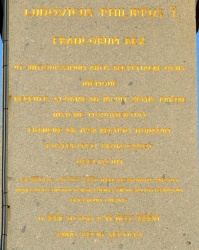 East side |
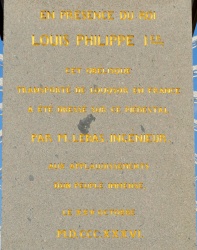 West side |
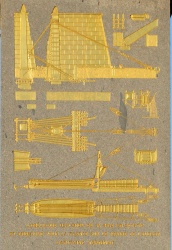 North side |
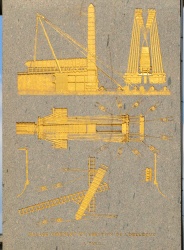 South side |
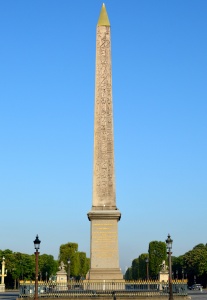 East side |
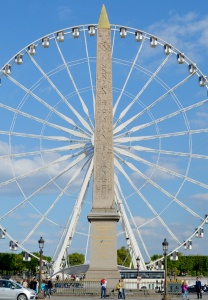 West side |
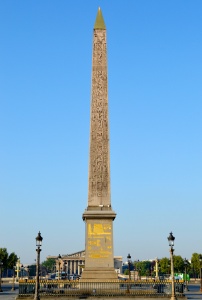 North side |
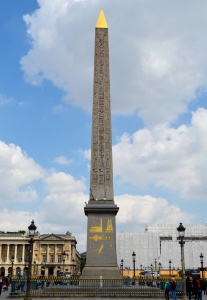 South side |
|||
April 29, 2017 by Hiroyuki Nagase (For high definition image, please click the picture) | ||||||
Copyright Hiroyuki Nagase nagase@obelisks.org and Shoji Okamoto okamoto@obelisks.org